Bike Check: Joe Nation's Pole Stamina
Joe Nation was revealed as Pole's new signing in December, and he'll be racing for the Finnish brand on their brand new bike, the Stamina. The Stamina is an evolution of the Machine, and is similarly produced from CNC machined aluminium. The Machine will now focus on general riding duties while the Stamina has one thing in mind - racing. Pole's production techniques mean they are able to rapidly prototype new bikes and have them under their racers almost instantly, as the Stamina proves.
So what are the differences between the Machine and the Stamina? Well the Stamina gets an extra 20mm of travel following feedback from the Whistler EWS last year, making it a 180/180mm 29er. This is apparently mainly down to fatigue rather than ability, the extra 20mm saves your legs a bit more on the long days out.
Geometry wise, the Pole Machine was already pretty radical, but the Stamina takes it even further left field. Another 0.4 degrees is cut from the head angle and it now sits at 63.5°, verging on downhill bike territory. The seat tube angle is now 80° (effective 81°) which is up from 78° (79°). The Stamina is also 1mm longer than the Machine and with a wheelbase of 1306mm on this medium frame it's a fair way beyond most EWS bikes at the moment. The rest of the geometry numbers are still being kept secret for now.
Joe's Stamina Details
• Intended use: enduro racing
• Rider Height: 178cm
• Rider Weight: 81kg
• Frame Size: Medium
• Wheel size: 29"
• CNC aluminium frame
• Rear wheel travel: 180mm
• 63.5° head angle
• Handlebar width: 760mm
• Shock: 140psi, no tokens
• Fork: 80psi, no tokens
•Tires: 22psi front, 26psi rear
• www.polebicycles.com
• Intended use: enduro racing
• Rider Height: 178cm
• Rider Weight: 81kg
• Frame Size: Medium
• Wheel size: 29"
• CNC aluminium frame
• Rear wheel travel: 180mm
• 63.5° head angle
• Handlebar width: 760mm
• Shock: 140psi, no tokens
• Fork: 80psi, no tokens
•Tires: 22psi front, 26psi rear
• www.polebicycles.com
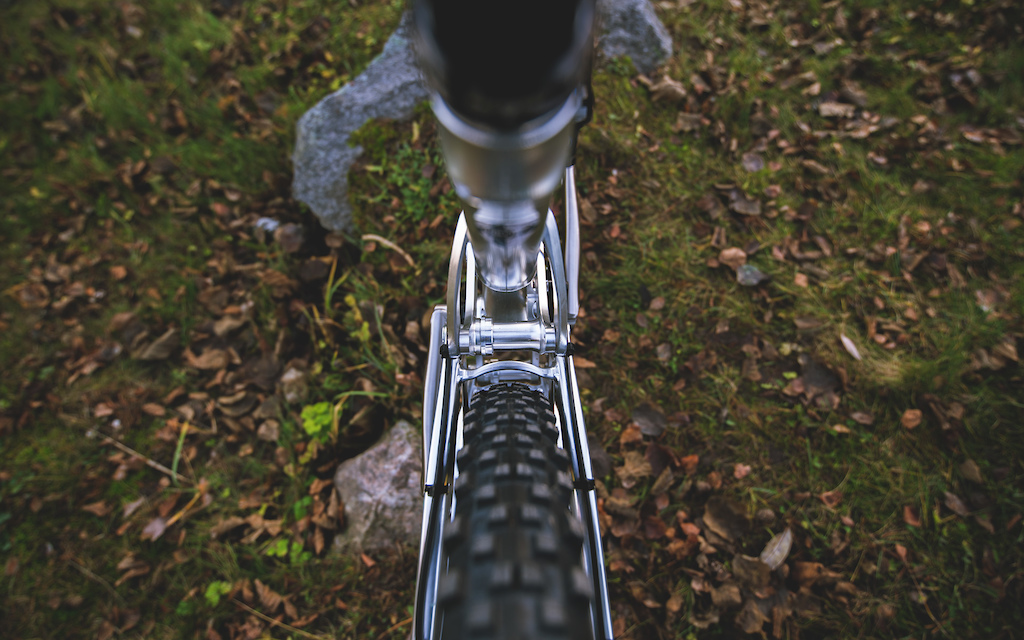
The seat tube on the Stamina is straight, as opposed to the Machine where it is curled round the shock. With he shock moved inside the front triangle, there is better access for the seat post cable and the shock is better protected from dirt.
Pole won't tell us how much this weighs at the moment but with their downhill Machine tipping 40lbs on the scales, don't expect it to be a featherweight. Pole's answer to this will of course be that durability comes above counting grams.
A race spec is yet to be finalised and the team were still testing out spec combos when these photos were taken at the team camp in Madeira, however there's plenty to ogle at while they work it out. The most obvious among that is a pair of Cane Creek titanium eeWings cranks that will certainly do no harm to that weight figure. The race bike runs RockShox front and rear with a mammoth 180mm, 29" Lyrik handling things up front and a Super Deluxe (250x75) keeping the rear wheel tracking. Mavic Deemax Pro wheels are shod in Michelin rubber, a combination that worked pretty well for Sam Hill these past 12 months. SRAM Descendant parts make up the cockpit.
A race spec is yet to be finalised and the team were still testing out spec combos when these photos were taken at the team camp in Madeira, however there's plenty to ogle at while they work it out. The most obvious among that is a pair of Cane Creek titanium eeWings cranks that will certainly do no harm to that weight figure. The race bike runs RockShox front and rear with a mammoth 180mm, 29" Lyrik handling things up front and a Super Deluxe (250x75) keeping the rear wheel tracking. Mavic Deemax Pro wheels are shod in Michelin rubber, a combination that worked pretty well for Sam Hill these past 12 months. SRAM Descendant parts make up the cockpit.
Spec
Fork: RS Lyrik RC2 Boost 180mm
Shock: RS Super Deluxe RCT
Brakes: SRAM Code RSC 200/200mm
Cassette: SRAM XG-1299 Eagle
Derailleur: SRAM X01 Eagle
Chainguide: Absolute Black
Crankset: Titanium Cane Creek eeWings
Handlebar: Descendant
Stem: Descendant
Seatpost: Bikeyoke Revive
Tires: Michelin Wild Enduro
Wheelset: Mavic Deemax Pro 29
Fork: RS Lyrik RC2 Boost 180mm
Shock: RS Super Deluxe RCT
Brakes: SRAM Code RSC 200/200mm
Cassette: SRAM XG-1299 Eagle
Derailleur: SRAM X01 Eagle
Chainguide: Absolute Black
Crankset: Titanium Cane Creek eeWings
Handlebar: Descendant
Stem: Descendant
Seatpost: Bikeyoke Revive
Tires: Michelin Wild Enduro
Wheelset: Mavic Deemax Pro 29
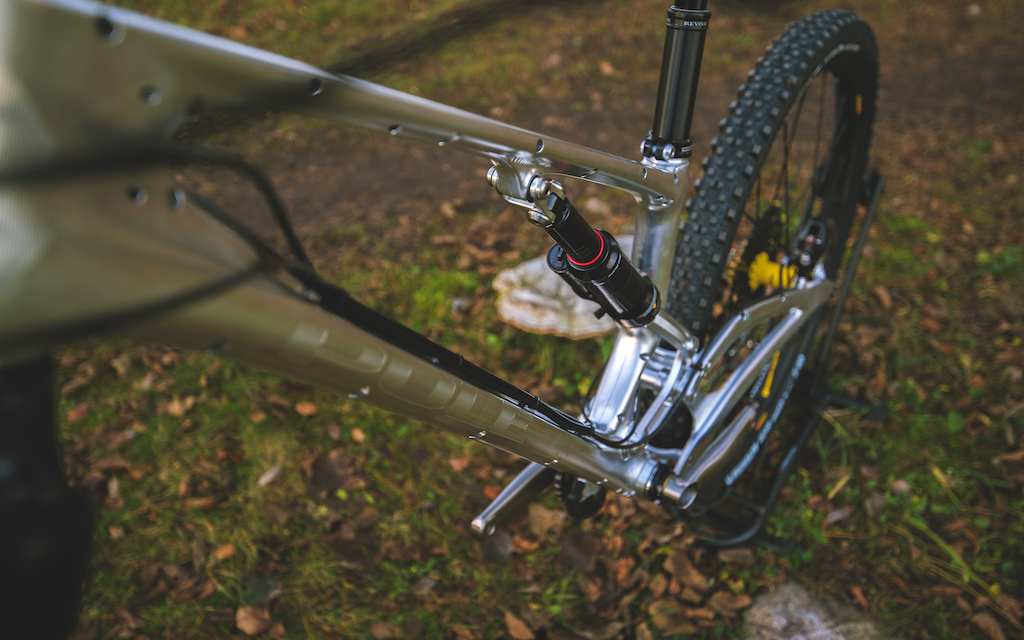
Joe runs his Super Deluxe shock at 140psi without tokens but has been testing with a 375 and 400lbs/in coil.
CNC detailing
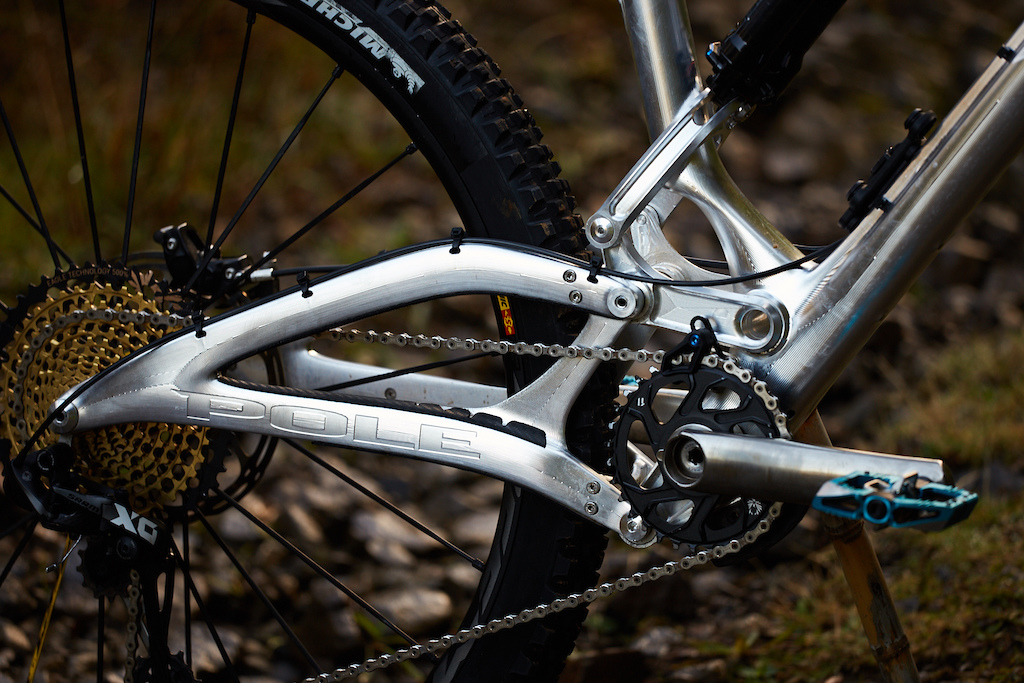
Not just a linkage, this bike is also foldable, and you'd have to with the size of it! Apparently the foldability has been improved over the Machine. The raw metal look is completed with those Cane Creek eeWings titanium cranks. We'd expect no less from a brand as staunchly anti-carbon as Pole.
MENTIONS: @polebicycles
Author Info:
Must Read This Week
Sign Up for the Pinkbike Newsletter - All the Biggest, Most Interesting Stories in your Inbox
PB Newsletter Signup

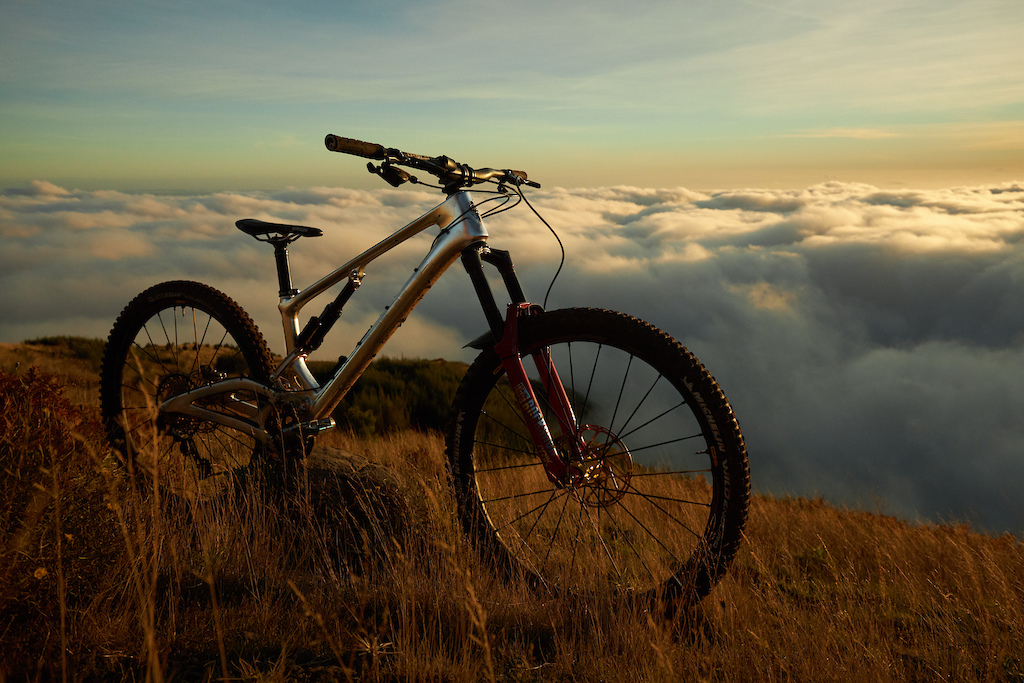
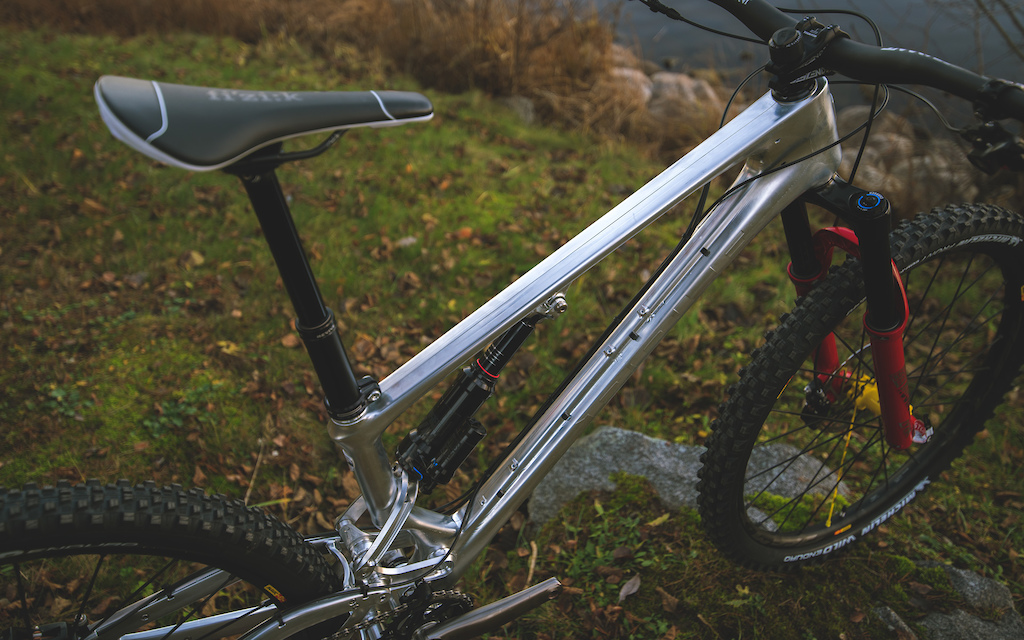
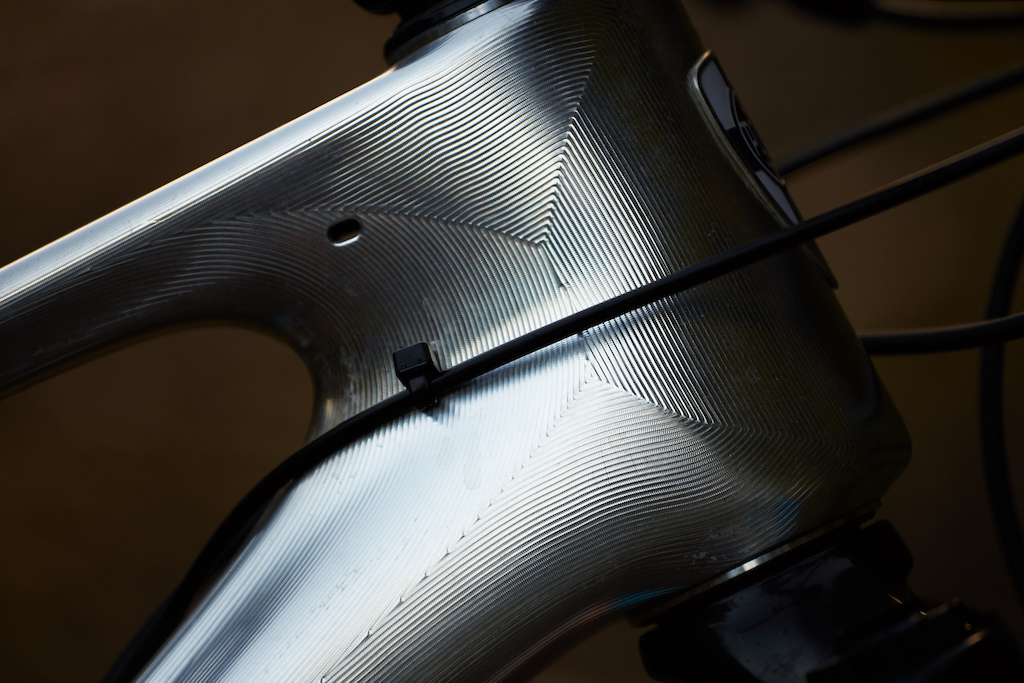


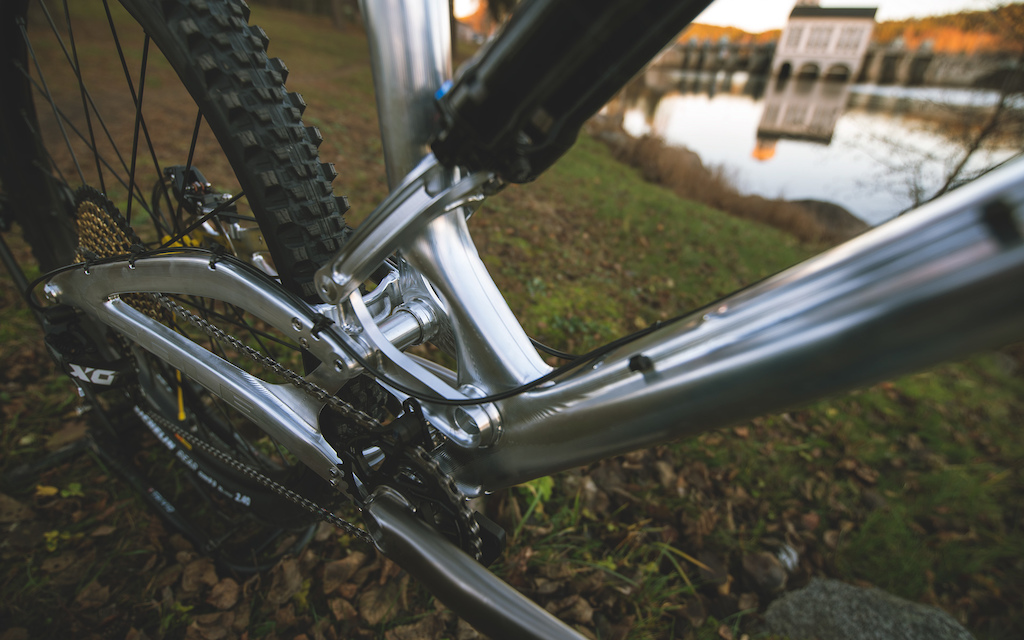
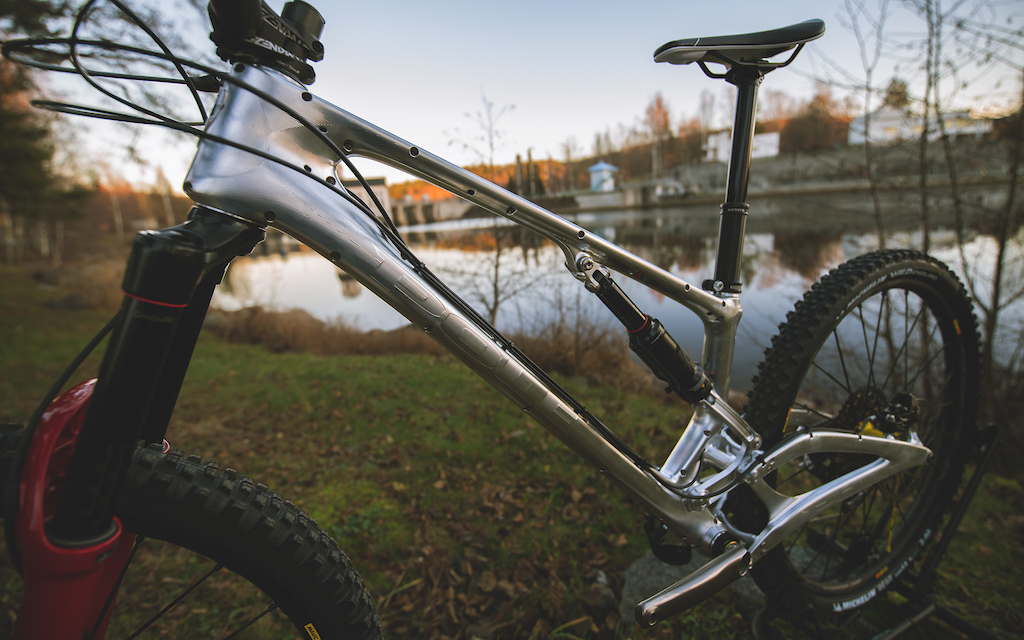


Understandably, the finish left here is pretty rough due to the desire to keep machine times lower. Judging by the pics, I can imagine that the finishing ballnose was absolutely flying around the frame (if you look really closely, you can even see evidence of the high feed-per-tooth - tiny ridges showing up perpendicular to the scallops).
While a smoother finish might lead to a higher fatigue life, the scallops have nothing to do with mismatch.
all three 3 Cdales cracked even though I never really crashed hard on them. seriously , just normal XC riding, no monster truckin, nuttin.
no comments about the model's real name should be Pole Smoker?
Can anyone confirm this is true?
I prefer the machined look but hey I'm not buying just looking.
PS: I have a Pole Stamina. It’s in ma’ pants.
In my opinion the surface finish has little importance as long as it does not cause functional issues, such as lower the fatigue resistance.
The size of the frame (or part) has nothing to do with the fatigue debit caused by the cusp. Fatigue curves (and associated debits/credits) are generated by making a boat load of test specimens and testing them. It's unclear if the cusp debit hurts the useful life of this frame in any meaningful way. For example, the debit could mean that this frame is only good for 25 years (vs 50 if it had a smooth finish) or it could be the difference between 2 seasons or 4. There is no way to tell without the material testing or a structural analysis.
Even with that data, the analysis is based on the load cases. A few huck to flats, a severe case or crash could be many orders of magnitude greater damage than what was planned for in the FEA analysis. Fatigue life is nonlinear. 10% more stress could mean twice the damage. For the non-engineers, you could look at it like this. You bike has a bank account and every time the frame is stressed, you pay. That money never gets returned. Some bikes start life with a lot more in the account than others, and typically this manifests itself in weight to reduce stress levels.
You're right about damage here. A harsh bottom out will cause more damage and since aluminum has no fatigue limit this does technically decrease the life of the part more than normal use. I suspect they keep the stresses low enough that the cycles for something like a harsh bottom out are up around 10^7. That's just a guess though. Where frames like to fail is when you do something out of the ordinary like hit a tree. The only aluminum frame I've had fail actually failed near the drop out while I was cornering because the chain rubbed in the highest gear and created a sharp groove.
We can not comment on the actual weight of the frame in production but at the moment we think it's going to be significantly lighter than the prototype Stamina and the Machine. We are currently going through the last phase of the design process. There are still going to be some changes to overall aesthetics and amounts of bolts etc. We start delivering the bikes approx in two months.
Cheers!
Everyone looks forward to the down of modern mountain biking. Some people even look forward to going up too.
Also do they ever responde to an e-mail? Looks like they are to busy posting stuff on facebook.
I would have already a pole hardtail if they actually responded to my mails.
Well guess I will look for a frame by a real company.
Instagram is poor for messaging as it can not be connected to multiple user accounts or link it to any professional customer service platforms. If you want any company to answer your requests, I suggest using Facebook or email. I'm sorry, but email is still the king in contacting companies. There is a corporate Whatsapp in development but it's not very common yet.
We are open to ideas. How would you like to contact us? I'll just say that we are not going to put up a call center because it's not going to work for numerous reasons.
With reach being measured from the bottom bracket to the head tube, any degree difference in the seat angle modifies the "effective" reach by around 11-15mm (i.e. the distance from where you actually sit to the handlebars).
With a slacker seat angle you naturally sit further back than with a steeper one, increasing the effective reach value.
So 510mm reach and 81° seat angle would actually be roughly comparable to a bike with 450-460mm reach and a 75-76° seat angle, in terms of the how stretched you'd feel on the bike (besides all the other effects like better climbing capabilities).
Bikes like this one show really well how misunderstood reach is and how useless it is.
With an ultra steep seat tube you need a very long reach to get the same cockpit length as with a slacker seat tube and an overall 'shorter' bike. That's why looking at reach numbers is so useless, but there's a caveat.
For riders with inseam length around 10 cm longer than the stack height, the effective top tube length is a very good approximation of cockpit length (handlebars ignored), likewise for the seat tube angle, the effective value. This is for M and L sizes and thereabout mainly. Once you go outside this 'average rider sweetspot' is where you get the problems. With the current seat tubes you get an ultra slack seat tube angle for XL riders and effectively an ultra steep angle for S/XS riders. So that's why in some way reach, effective top tube and effective seat tube angle values work, because they work for the average rider. But they do not give the complete picture for the complete population. And you always have some smartasses that stick out of the average and spill vitriol over the internet.
Sincerely, should_be_riding_an_XL_Pole guy.
No, the steep seat angle takes away the extreme ‘effective top tube’
At the end of the day, you increase reach, you increase wheelbase, no way around that.
On a side note, I think seat angles cant really go past about 80 degrees otherwise peoples knees would be falling off due to poor bike fit. When you are seated with feet on peddles at 3 and 9 o clock, your kneecap should be directly above the peddle axle. To far in front (or behind) and you’ll end up with knee pain...
Reach is a useful measure because it tells you something about how a bike will handle when you are standing on the pedals, not sitting in the saddle. For enduro racing, where the rider is standing for the overwhelming majority of the timed parts of the course, handling characteristics when standing are the most important.
The "effective reach" that you are describing is irrelevant when you are standing.
The knee thing has been debunked, not that it matters since it was really based on a flat level ground measurement. Up really steep climbs you could have a 85 degree STA and have knees behind pedal....which is kinda, like, the whole point here....
You are right.
I don't care about steep SA.
I had enough knee pain issues already.
My idial angle is around 72.5° with 175mm cranks.
Arguing counter is like saying a steeper head angle is better for weight distribution on steep descents.
The knee over pedal thing doesn't make sense since you can rotate the whole system, check those criteria but don't change the forces inside the system. The forces in the knee.
O
Also enduro bikes, standing up and the like, the downhill performance above all matters to the racers and even then sparing some energy on a liaison can be nothing but beneficial. For the average rider of an enduro bike sparing energy while seated (as mentioned, 90 percent of the ride) is also most important, because said average rider rides and even races for fun.
If downhill performance is above all other criteria, why don't you guys run shock rates that the pros ride? Clearly they work the best, otherwise they wouldn't use them.
And no, you (you as in 99 percent of all people on pinkbike) ate not at the level where you can argue you need descending performance over bike fit. After all, what good will 0.05 percent improvement going down help when you injure yourself on a liaison due to a poor bike fit?
"Further analysis of other lower limb muscles is therefore warranted to fully explain neuromuscular mechanisms underlying improved metabolic efficiency when cycling at steeper STA."
A friend of mine has a PhD from kinesiology and he is a bike fitter now and he more or less said that steeper is more efficient a while ago, before the steep seat tube angle craze.
A lot of what we see in production is based on what product managers believe their customers are expecting.
Customers and journalists do not like big changes and company boards to not like risk. Geometry changes are very slow but it is obvious that they are creeping towards a much steeper seat tube angle.
In TT it is argued that sitting on the tip of the saddle allows for a more aero riding position, which doesn't matter for MTB. While Triathletes argue that sitting further forward saves power in their hamstrings for running. Which is the exact opposite of what was claimed above, that a forward riding position would involve the hamstrings more.
On bikes with with slacker STA I feel that I loose a lot of energy trying to keep the front on the ground.
On the road this does not matter for climbing, you just stand up in the steeps, but I also find a more forward position more natural.
Knee over pedal makes sense in some instances, but the rule ignores a lot of complexity in a mountain bike situation.
polebicycles.com/stamina
I assume single crown fork will flex way before that...
I’m intrigued, but not for me. Would love to try one though!
Seems the rider specs should be separated from the bike specs, which themselves are in two separate boxes.
I like the idea of the progressive geometry but flow trails are really not a strong point at all.
What you'll find if you give it a fair shake is that wheelbase has little if anything to do with overall maneuverability. Positioning between the wheels, relationship of stem length to fork offset (this is HUGE, and widely misunderstood), and fork length (A2C) are all way more important. Although this opinion will be unpopular with some of the forum dwellers, there's a reason that literally every mountain bike brand is moving in this direction. It's because it works better, and if you're going to shell out to upgrade, your new bike should damn well be better than your old one.
As a rule, "new school" geometry reduces the amount of body English you need to put into the bike. It also tends to demand that the rider shift their weight a bit farther forward. That can take some getting used to, but it's well worth the effort ATMO. It's also worth noting that, as ever, wheel size makes a difference. Big wheels and lots of BB drop makes for a bike that's more stable. Smaller wheels and less drop makes for a bike that's more responsive. New geometry hasn't changed that at all.
There are certainly compromises at the more extreme end of the geometry scale in either direction, but they might not be what you'd expect. The Poles, for example, actually corner VERY well even at lower speeds, but the timing is different than a more traditional bike. You also need to have the skill to carry momentum and lean, not steer. Where Pole loses me personally is that the combination of the massive reach and long rear end requires pretty dramatic weight shifts front to back if you're trying to link up technical manual lines, or if you're nosing into a steep landing. That said, if you're into riding flat out in open terrain, those things are very nearly in a league of their own. Not something I need to own, but a VERY cool option for the right rider.
My Ripmo, on the other hand, is definitely new school, and it's one of the EASIEST bikes to blast whips, slap corners, and generally get buck with that I've ever ridden, and I test and review a HUGE chunk of the new bikes from a ton of brands every year as part of my job. Obviously, I'm biased in favor of the new stuff. I just want to ride the best bikes that I possibly can, and we're at a point in mountain bike development where BIG improvements are being made every product cycle (Boost notwithstanding). Some people might think that makes me a shill. Hopefully it's apparent that in reality, I just have a lot more experience in with the latest gear than the average forum poster, and I'm trying to share that experience to help others make informed choices. Take that for what you will.
It looks like you're in CT? As you know, the riding there is pretty unique. With the trails being relatively slow and technical, you'll want to go on the steeper, and probably shorter end of the new bike spectrum. With all the rocks, some cush will definitely help. If you can, start by demoing a new Bronson on the Plus wheel package (I HATE Plus tires, but ~35mm rims and Maxxis WT tires make for a genuinely amazing setup) That bike is pretty conservative numbers wise, and it's REALLY good. If you don't like it or prefer your old bike, that's totally fine too. Happy hunting!
And hell no- 470mm reach are the max. for me with 180mm- These long bikes feel like boats and most people dont have the trails to ridde them thee intended purpose.
I dont want to constantly center myself on the bike- youll get exhausted faster.
The Ripmo/Stumpjumper Evo etc. are not that crazy but for sure "easier" to ride.
Constantly riding with bent ellbows and Always in attack positoon isnt what I call easy... You may be a bit faster but I wont be exhausted and do more laps.
Just to be sure: I dont mean 460mm Reach bikes long- Im talking 480mm++
BTW not sure if you are shorter is a good idea on this bikes to use short stem, cause you need to put more wheigt on the front for grip...
The Capra also does it.
I feel if it ran more parallel to the down or top tube it would be more visually appealing
Ps. I'm loving the look of the new rear triangle!
"A shorter travel CNC-machined bike will be released this spring, stay tuned!"
:-)